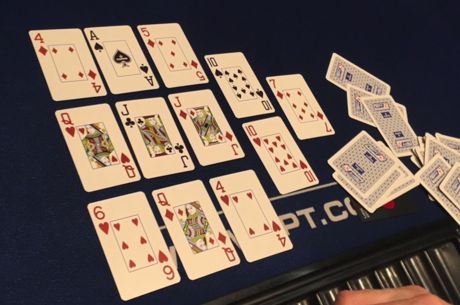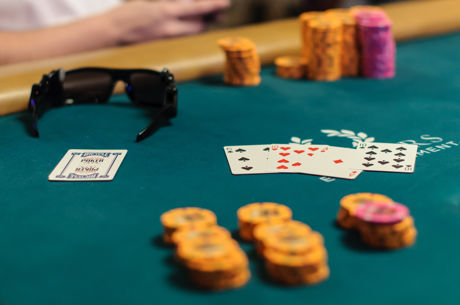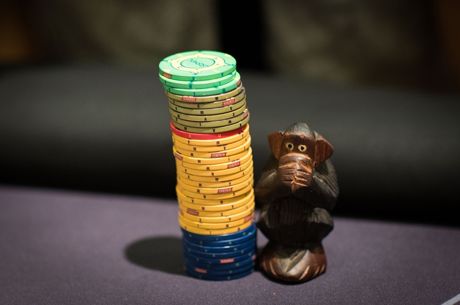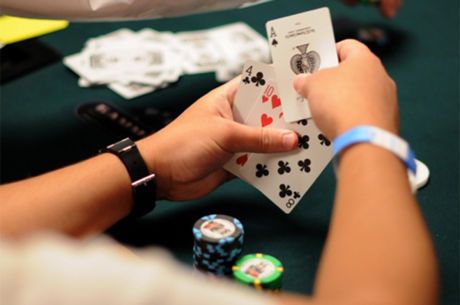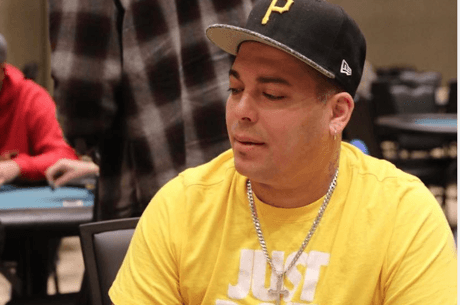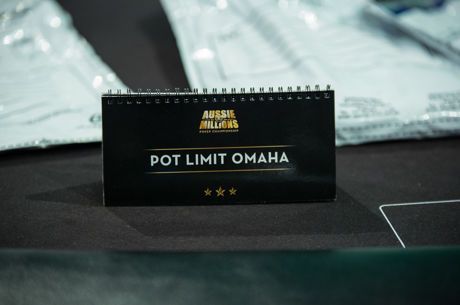No-Limit Omaha-8 -- What Could Possibly Go Wrong?
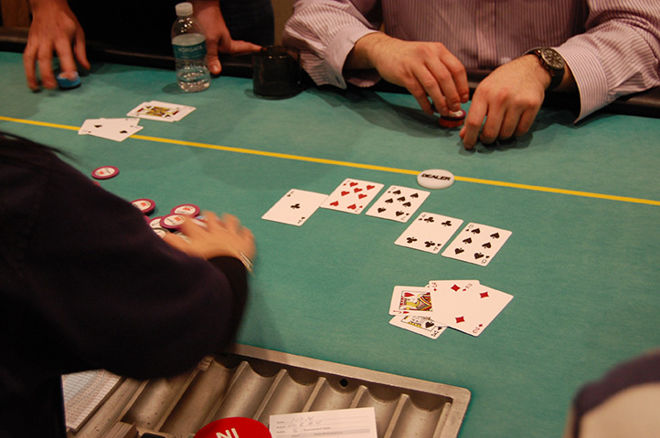
As promised, here is the first specific strategy piece in a series of articles about poker games that aren't no-limit hold'em (!). First, don't panic �� it's going to be fine; you might actually find yourself enjoying them.
The first one we're going to discuss is actually fairly popular on PokerStars: NLO-8 (no-limit Omaha, high-low, with an 8-qualifier for low). So instead of two cards, you get four. And the pot gets split between the best high hand and the best low hand �� if there's a qualifying low hand.
What could possibly go wrong?
Omaha
If you've never seen or played Omaha, you're in for a treat. Instead of two cards, you get four.1 So instead of one two-card combination, you have six. The point about the number of two-card combinations is crucial because you must play exactly two cards from your hand and exactly three cards from the board. Examples:
- If you have K?4?K?6? and the board is 8?5?J?10?2?, you have a diamond flush. But if you have A?4?K?6? and the board is 8?5?J?10?2?, you do not have a flush.
- If you have K?4?Q?6? and the board is 8?5?J?10?2?, you do not have a flush.
- Three of a kind of anything in your hand is very bad. Normally, even trip aces in your hand are unplayable.
- There is no such thing as "playing the board." If the board is 8?8?8?8?7?, nobody has quads (the nuts is a pair of aces in your hand).
You will make "two cards in your hand" mistakes during your Omaha career �� it's often wise to play a few hundred (or thousand) play money hands on PokerStars before making those mistakes for real money.
I also encourage you to practice reading Omaha boards until you're pretty sure you can evaluate your hand (and the nuts) quickly.
High-Low 8-or-better
If you've never played split-pot games (or low games such as razz and deuce-to-seven) before, don't worry �� it's easy. It's just a different ranking of poker hands, one that's actually far more intuitive than the normal ranking that we all use. It works like this:
The best hand is the lowest five unpaired cards. The highest card among those five must be eight or lower to "qualify."
Again, examples:
- 9?7?6?3?2? is not a low hand. The nine disqualifies the hand.
- 7?6?6?3?2? is not a low hand. The pair of sixes disqualifies it.
- 7?5?4?3?A? is a very good low hand. The flush doesn't count against you.
- 5?3?4?A?2? (a wheel) is the nuts. The straight doesn't count against you, and aces play low.2
Hands are generally declared by the highest one or two cards in the hand, since that's how you determine a winner. If I say "8-6," that means I have a low hand, the highest two cards of which are an eight and a six. If you then say "8-6-what?" it generally means that you have an 8-6 as well, and we have to go to the next card to determine the winner. For instance, your "8-6-4" would beat my "8-6-5."
As a historical note, it's obviously possible to play high-low split with no qualifier, but for the last 20-30 years, almost all split-pot games have a qualifier for low (usually an eight-or-better). Furthermore, they're all played "cards speak," rather than the "declare" you may have played in kitchen table games with your Uncle Ralph.
Combining it all
The only thing you really need to know at this point is how to read low hands when you're looking at four hole cards and as many as five board cards. It's not trivial, and you'll often see even experienced dealers looking at a bunch of hands face-up on the table, trying to figure out who wins the low half of the pot. As always, examples help.
- The board is 8?5?J?10?3?. This is a classic Omaha "low possible" board. Anybody with an Ax2x combination in her hand has the "nut low" and will get at least a portion of the low half of the pot.3
- Anne has 5?4?3?K?; Bill has K?6?2?7?. The board is 8?5?J?3?2?. Anne's best hand is 8?5?4?3?2? ("8-5"); Bill's best hand is 7?6?5?3?2? ("7-6"), so Bill wins the low half of the pot (Anne's two-pair (5's and 3's) wins the high half).
- The board is 8?5?J?10?5?. No low is possible; the high hand will win the entire pot.
Again, there is no substitute for playing a few hundred hands and being sure you know how to read the board.
No-limit betting
Interestingly, for a very long time Omaha High/Low 8-or-better was played almost exclusively with fixed-limit betting. And it's still played in that format as part of HORSE and 8-games, and as a standalone game unto itself. But as players began to branch out from no-limit hold'em, many of them liked the betting format where they could click an "All-in" button. Thus arrived NLO-8.
What could possibly go wrong?
NLO-8 Strategy
There's a well-known story of Jennifer Harman getting a 20-minute intro to deuce-to-seven lowball from Howard Lederer shortly before a WSOP event in the game, and then going out and winning the event and its bracelet. Most of us are not Jennifer Harman, but if you apply good fundamental poker skills (which I advocated in the original article) you can probably hold your own, and perhaps win a few dollars. So here goes...
Play hands that work well together
As I noted at the top, Omaha offers six two-card combinations to each player (rather than just one, as in hold'em). One excellent card combination is rarely enough to justify playing a hand (with the exception of two aces, and even that has its limitations). Two good hold'em hands does not a good Omaha hand make. You want everything to work together.
Avoid what the Omaha crowd calls "danglers" �� e.g., a hand such as Q?J?10?4?, where one card is virtually worthless. You've got three decent two-card combinations; if a big pot breaks out, you may well be up against an opponent with twice as many working two-card combinations.
Avoid middling cards
In Omaha-8, middle cards are a mess. They don't work well for low, and if they get into high hands, they're not the nuts. Some Omaha players will tell you never to play a hand that has a nine in it. That may be a bit over-prescriptive, but it's not a bad place to start.
Suppose, for instance, you have 10x9x8x7x. If you make the nut straight, a low draw is possible if not already arrived. If you make a non-nut straight, well, non-nut straights in Omaha are a good way to lose all your chips.
Opposite to nines and tens, aces are golden. They build the nuts at the high end, and are the perfect low card. Seek ye aces and reject ye nines and tens.
Play hands that can scoop a pot
You rarely make a big profit when you chop a pot, and sometimes you literally lose money, usually by being quartered (you get one quarter of the pot because you chopped half the pot with somebody). The way you make massive wins in split-pot games is to persuade an opponent (or two) that they are good for half the pot when they're not. It's one thing to get a hold'em player to put a ton of chips in the pot with a second-best hand. But if your opponent believes that she's guaranteed to get her money back, but she's not, well, that's when you win stacks.
Thus play hands that have "both way" value, such as A? 3? 5? K?. Here you can make a very good low (it will help a lot if a deuce hits the board, nutting up your low draw) and potentially the nut diamond flush. You can also play hands such as K? Q? J? 10?, since if you hit your hand, it's likely that a low won't be possible. On the other hand, be prepared to quickly abandon ship if a couple of low diamonds come out. You're drawing at a non-nut flush and you're probably only arguing over half the pot to start with.
Pairs aren't that big a deal
Quite often, you need to flop a set to win an Omaha pot. But middle and bottom sets are how you can lose big money. A hand such as J? J? 8? 6? is not really playable in NLO-8. It's likely to cost you much more money than it will win. A set of queens can be the nut high, but if it is, a low is possible, and likely. A hand such as K? K? 9? 2? is basically junk.
Set-mining is not as profitable in Omaha as it is in hold'em, and it can often be costly. Again, get four cards that work together.
Don't go to war just because you have the nuts
Suppose you have the aforementioned K? Q? J? 10? and the flop comes 9? 7? 8?. You've flopped the nuts, with a redraw to a higher straight �� congratulations. Despite this, you should tread extremely carefully, particularly if you have more than one opponent.
Somebody has a low draw and somebody has a club flush draw. Against one opponent holding A? 6? 4? J?, you are a 3-to-2 underdog. Against two opponents, one of whom has a bare club flush draw and the other a bare low draw, you have 38% equity �� enough to put lots of money in three ways, but you could easily be up against a matching straight plus the flush and/or low draw. If so, you are in equity hell.
Many experienced Omaha players prefer to see a safe turn card before committing a lot of chips. For instance, in the scenario where you're up against a single opponent with both the flush and low draw, you're a 3-to-2 underdog on the flop. But if the safe K? falls on the turn, you become the 3-to-2 favorite. When big draws are possible, discretion can often be the better part of valor.
Buckle your seatbelt
Omaha-8 is frustrating enough. Adding no-limit betting just makes the action bigger and wilder. You will see players desperately trying to protect (for example) a flopped nut low (or nut straight) with massive overbets on the flop �� don't be doing that. Get good value for your big hands, and accept that you often have to fade a lot of outs.
The best Omaha players will show up with a hand that is currently the nuts, but has redraws to better hands; that's where you make your serious money.
Summary
NLO-8 is a big departure from no-limit hold'em, but many people find it addicting. And on PokerStars, the software automatically determines the best hand and splits the pots in milliseconds. So you get all the fun without the hassle. Many people think that once they've got four cards from which to choose a two-card combination, hold'em pales in comparison.
Let us know what you think. After all, what could possibly go wrong?
Footnotes:
Lee Jones has played poker seriously since the mid-1980s and been part of the online poker industry since 2003, most of it (and currently) with PokerStars. He is the author of Winning Low Limit Hold'em, which is still in print, 22 years after its initial publication. You can read his occasional Twitter-bites at @leehjones.

